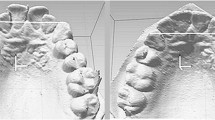This paper presents the results of studying the effectiveness of the developed method for diagnosing the functional state of the dental system. The results indicate that the accuracy of the method is about 80%. The results of previous studies are reviewed and the prospects for diagnosis of the functional state of the dental system as a research and practical trend in dentistry are outlined. The physiological regularities of the dental system functioning and relationship between its functional status and the autonomic nervous and postural systems prompt a new trend of research, functional diagnosis in dentistry and interpretation of the findings of functional studies. The prospects of functional diagnosis in dentistry are discussed.
Similar content being viewed by others
References
Solovykh EA, Bugrovetskaya OG, Maksimovskaya LN. Information value of functional status of the stomatognathic system for postural balance regulation. Bull. Exp. Biol. Med. 2012;153(3):401-405.
Fujino S, Takahashi T, Ueno T. Influence of voluntary teeth clenching on the stabilization of postural stance disturbed by electrical stimulation of unilateral lower limb. Gait Posture. 2010;31(1):122-125.
Golub GH, Reinsch C. Singular value decomposition and least squares solutions. Numerische Mathematik. 1970;14(5):403-420.
Keogh E, Mueen A. Curse of dimensionality. Encyclopedia of Machine Learning and Data Mining. Saummut C, Webb G, eds. Boston, 2017. P. 314-315.
Maaten L, Hinton G. Visualizing data using t-SNE. JMLR. 2008;9:2579-2605.
Milani RS, De Perière DD, Lapeyre L, Pourreyron L. Relationship between dental occlusion and posture. Cranio. 2000;18(2):127-134.
Rousseeuw PJ. Silhouettes: a graphical aid to the interpretation and validation of cluster analysis. J. Comput. Appl. Math. 1987;20:53-65.
Solovykh EA. Coordination of the stomatognathic and postural system activities and their functional status. Bull. Exp. Biol. Med. 2013;155(1):92-95.
Solovykh EA, Bugrovetskaya OG, Maksimovskaya LN. Classification of patients by the function of dentition, postural and autonomic nervous systems. Bull. Exp. Biol. Med. 2012;153(6):912-916.
Solovykh EA, Maksimovskaya LN, Bugrovetskaya OG, Bugrovetskaya EA. Comparative analysis of methods for evaluation of stabilometry parameters. Bull. Exp. Biol. Med. 2011;152(2):266-272.
TMJ Disorders and orofacial pain: the role of dentistry in a multidisciplinary diagnostic approach (Color Atlas of Dental Medicine). Bumаnn А, Lotzmann U, Groot Landweer G, eds. New York, 2002.
Author information
Authors and Affiliations
Corresponding author
Additional information
Translated from Byulleten’ Eksperimental’noi Biologii i Meditsiny, Vol. 166, No. 10, pp. 518-522, October, 2018
Rights and permissions
About this article
Cite this article
Solovykh, E.A., Leont’ev, V.K., Zubrikhina, M.O. et al. Efficiency and Prospects of Diagnosis of the Functional State of the Dental System. Bull Exp Biol Med 166, 517–521 (2019). https://doi.org/10.1007/s10517-019-04385-4
Received:
Published:
Issue Date:
DOI: https://doi.org/10.1007/s10517-019-04385-4




